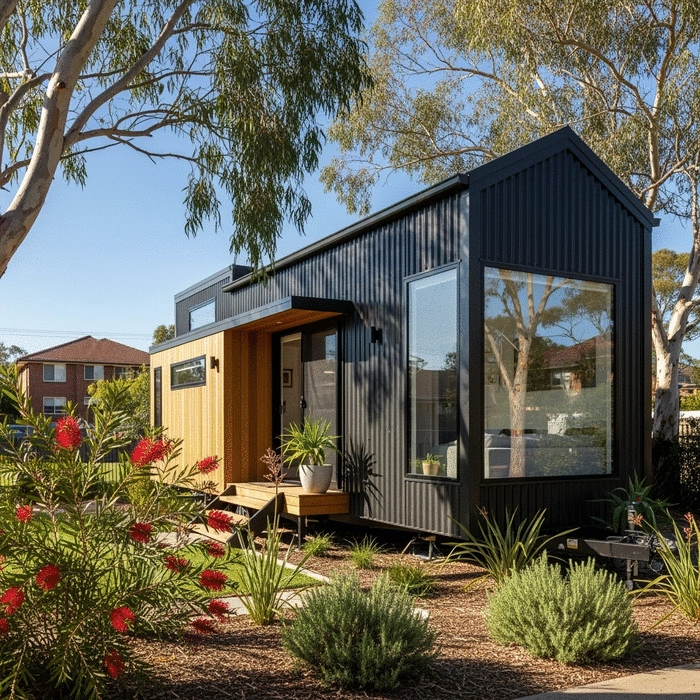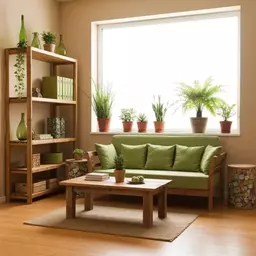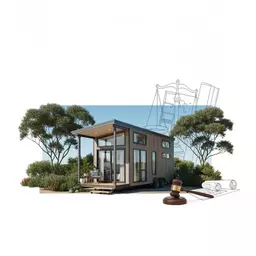Permanent Dwellings
- Built on a foundation
- Require building permits
- Must meet specific building codes
Get expert advice, innovative design ideas, and practical tips for your tiny home journey in Australia.
Posted on: 2025-10-28
By: Sophie Marchant
Imagine a life where your home is not just a place to live, but a stepping stone towards sustainability and financial freedom. The tiny house movement is transforming the way we think about our living spaces, and understanding the zoning laws that govern this lifestyle is crucial for aspiring tiny homeowners in Australia.
The classification of tiny houses significantly affects zoning laws and regulations. Below is a visual comparison of the two main classifications: Permanent Dwellings and Moveable Dwellings.
As someone passionate about the tiny house movement, I know how crucial it is to understand tiny house zoning laws in Australia. These laws dictate where you can park or build your tiny home, and they differ significantly across various regions. By navigating these regulations, you can ensure that your journey towards a debt-free and sustainable lifestyle is as smooth as possible! For a more detailed look at the regulatory landscape, you can learn more about tiny house zoning laws explained.
At The Tiny Living Guide, we aim to empower you with the knowledge needed to make informed decisions. Let’s dive into the essential aspects of tiny house classifications and the significance of zoning laws for prospective owners.
Before we tackle zoning laws, it’s important to understand what qualifies as a tiny house. Generally, tiny homes are classified into two categories: permanent dwellings and moveable dwellings. Each classification affects how they are treated under local zoning laws.
Permanent dwellings are typically built on a foundation and often require building permits. In contrast, moveable dwellings, like tiny houses on wheels, are generally seen as caravans or RVs, which can have different regulations. This distinction can impact where you can live in your tiny home.
A tiny house is often defined by its size, usually being under 50 square meters, but what really matters is how it’s classified. A permanent tiny home will need to meet specific building codes and regulations set by local councils. On the other hand, moveable tiny homes, though easier to relocate, must comply with caravan regulations.
Understanding these differences is vital as it helps you determine the best option for your lifestyle. Will your tiny home be a fixed sanctuary or a mobile adventure? This choice will shape your zoning journey! If you're considering the practicalities of a mobile tiny home, you might also be interested in how to build a tiny house affordably.
Caravans play a significant role in tiny house zoning discussions. Many local councils consider tiny houses on wheels as caravans, which often have more lenient regulations. Here are some key points to remember:
Understanding zoning laws is essential for tiny house owners because they greatly impact where and how you can live. Zoning regulations can restrict the use of land, affecting everything from parking options to the design of your tiny home. Keeping track of these regulations can help you avoid potential headaches down the road.
Moreover, zoning laws also influence the overall acceptance of tiny homes in a community. As a passionate advocate for sustainable living, I believe that knowing these laws can empower you to advocate for your own tiny home journey and contribute to a larger movement!
The implications of zoning laws on tiny house ownership can be significant. Here are some considerations to keep in mind:
Local councils play a pivotal role in shaping zoning laws for tiny houses. They determine whether tiny homes can be classified as permanent or moveable dwellings, and their regulations vary widely. I encourage you to research your local council’s guidelines and reach out with any questions—most councils are more than willing to help!
By engaging with local councils, you can better understand their stance on tiny homes and how to navigate the regulatory maze. This knowledge can be a game-changer on your path to tiny living!
The Tiny House Association Australia is an invaluable resource for tiny house enthusiasts. Their mission is to advocate for our community and promote awareness of tiny living. Here’s how they can assist you:
Connecting with the Tiny House Association can help you navigate the regulatory landscape and empower you to make informed decisions as you embark on your tiny living journey!
When navigating tiny house zoning laws, consider joining local advocacy groups or forums dedicated to tiny homes. Engaging with others who share your passion can provide invaluable insights and support, helping you stay informed about changing regulations and best practices in your area.
Here are some common questions about tiny house zoning laws to help you on your journey:
As we wrap up our exploration of tiny house zoning laws in Australia, it's essential to understand the core principles that guide us in navigating this unique landscape. Tiny living requires us to be aware of local regulations and how they impact our dreams of a simpler lifestyle. By keeping abreast of these laws, we can make informed decisions that pave the way for our tiny homes. After all, knowledge is power when it comes to creating the life we envision!
One critical aspect is the nuances of zoning regulations. Each local council has its own set of rules, which can vary significantly. Thus, it's crucial to dive deep into the specific laws governing your area. This diligence will not only save you time but could potentially prevent costly mistakes down the road. Remember, your tiny home journey begins with a solid foundation of understanding!
Here are the key takeaways to ensure compliance with zoning laws:
Engaging with local councils and staying connected with the tiny house community can also provide support and insight into navigating these regulations. We all share a vision of a simpler, more sustainable life, and together, we can work towards making tiny living a reality.
Here’s a quick guide to get you started on your tiny house journey:
At The Tiny Living Guide, we believe that taking these steps not only empowers you but also contributes to a growing community of tiny house enthusiasts across Australia. The more we advocate for our needs, the more chances we have for positive change! You might also find our guide on choosing your ideal tiny home helpful as you plan your next steps.
Tiny houses are more than just a trend; they represent a significant shift towards sustainable living. By embracing this lifestyle, we can live more harmoniously with nature and contribute to a more balanced urban environment. Imagine a world where our living spaces are not only cozy and personal but also eco-friendly! For more insights, explore how to incorporate sustainable living in tiny homes.
In urban settings, tiny houses can play a pivotal role by:
As we advocate for tiny living, let’s inspire others to consider this fulfilling lifestyle! The tiny house movement is about community and support, and every story shared can spark motivation in someone else. Together, we can make a difference!
Engaging with the tiny house community is a wonderful way to share experiences and insights. Here are some ways you can connect:
Your tiny house journey is not just about building a home; it's about fostering a community of like-minded individuals who share a passion for sustainable living. Let’s work together to create a world where tiny homes are not only embraced but celebrated!
Here is a quick recap of the important points discussed in the article:

 What if your small living space could also be a sanctuary for the planet? Embracing sustainability n
What if your small living space could also be a sanctuary for the planet? Embracing sustainability n
 As the tiny home movement gains momentum in Australia, the legal landscape can feel daunting. Howeve
As the tiny home movement gains momentum in Australia, the legal landscape can feel daunting. Howeve
 Did you know that zoning laws can significantly impact the feasibility of sustainable housing initia
Did you know that zoning laws can significantly impact the feasibility of sustainable housing initia